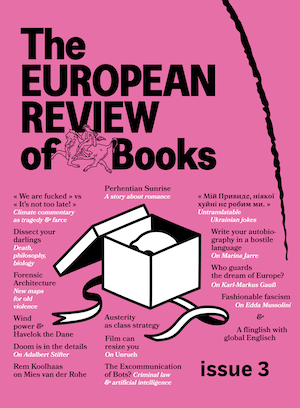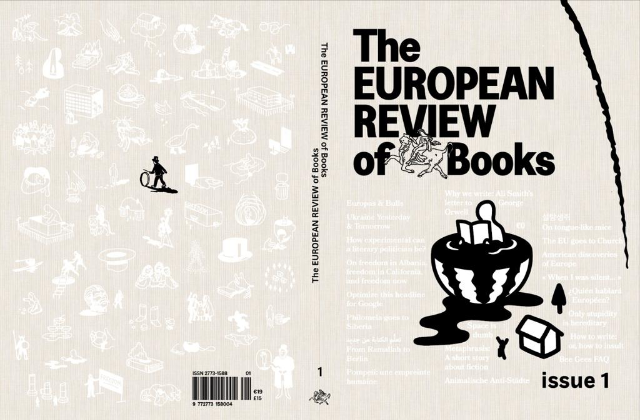But what is the European Review of Books?
Here’s a primer. In a little over a year we’ve made five book-length issues. We dare say they’re beautiful. They’re also unusual. In print, the pages are uncut: turn them to read, but cut them — easily done with a finger, also satisfying with a bookmark, knife or brillenpootje — to open a second layer, where you’ll find shorter essays, asides, the occasional language game and bursts of color. Rip it to read it. (Online, as on this page, paratexts beckon to you from the margin.)
In print, cut the pages to open a second layer. Online, a level 2 beckons from the side (like this)

And what is in those pages? We have committed to that form (both old-fashioned and newfangled) because we’re committed to a broad sweep of languages, and to being, well, something else. The « European » intellectual atmosphere is thin, as culture is filtered through national and metropolitan sieves. Our goal is to thicken it. We publish many kinds of writing: fiction, travelogue, provocation, poem, come what may. Allergic to « opinion », we gravitate to the essay: avenue to the arcane, the profane, the grand.
We are a small operation. We want the magazine to grow, and we want it to endure. There’s so much yet to be done with the form that we have found.
Here’s what you can do:
☞ Subscribe!
☞ Ask your librarian to subscribe. Pieces in the ERB can enrich course syllabi. They also offer fruitful research and multiple perspectives for foundations, think tanks and other institutions.
☞ Sign up for our newsletter and spread the word.
We publish in English and in a writer’s own tongue. This catchy little video explains our approach:
Here are some good points of entry from our first three issues:
Essays
➞ Europas & bulls: On a logo and where it takes you.
➞ Walter Grünzweig on Robert Habeck, German vice chancellor & novelist-statesman
➞ Adania Shibli on writing between Ramallah and Berlin
➞ Ali Smith on George Orwell
➞ Rem Koolhaas visits Palmyra on the brink of war (« What is a pillar? »)
➞ Peter L’Official on racial metonymy and the art of misidentification
➞ Mathieu Segers on Curzio Malaparte’s Europe — and ours
Fiction
➞ « Perhentian Sunrise »: Preeta Samarasan’s story about romance
➞ « Metaphrasis »: Menachem Kaiser’s story about, well, fiction
Reviews
➞ Ingo Venzke on climate commentary as tragedy & farce
➞ Linda Kinstler on freedom, Albanian and Californian
➞ Sarah Watling on Edda Mussolini and fashionable fascism
➞ Oksana Forostyna on Ukraine’s global history
Poetry
➞ Yu Müller’s Chinese palindromes (read them twice!)
➞ Kim Hyesoon’s « Sugar Mouse », with an adventurous translator’s note by Mia You
Pearls
➞ Artemy Kalinovsky on astronautical tokenism
➞ George Blaustein on zero-euro bills and imagined Marxes
And here are some favorite lines, in our contributors’ own voices:
Thanks for reading. We hope you enjoy what we’ve made.

When there are a zillion decisions to make, it can feel like the decisions are making you. Among our decisions: size (a bit bigger than a book, but smaller than newsprint), layout (two columns throughout), typeface & punctuation (long live the « guillemet »), the wonders of style-guide construction. How to distinguish a short story from a review from an essay? Where to place the noble footnote? When to hold a reader’s hand and when to let them ramble? What is our theory of section breaks? Korean first or English first? We obsessed over rules only to realize that sometimes we had to break them.

Some small decisions weren’t small at all: note that « The European Review of Books » appears twice on the spine, in two directions, because some contexts count a book’s vertebrae upward and others count down. (Which side of the road to drive on? Which cheek to kiss first? The arbitrary poetry of social custom.) The ERB, as you’ll see, is a strange puzzle-box of a book, but we wanted it to fit on any shelf.
Level 1’s and level 2’s, interpages, paratexts—the ERB’s editors and designers have been throwing these terms around among ourselves. Now that the structure is in place, we’re keen to see what contributors will make of it. Kill your darlings, we can say, but also keep your darlings, for they may end up between the pages. (What is an interpage, but a garden cemetery of killed darlings?)

The website was its own intricate design riddle: not only for moving between languages, but for moving within an article itself. To that end you’ll find gems studding many a margin. Click them! They want to be clicked.
Other features are built with a future in mind, notably our ever-expanding Library, which subscribers will be able to browse, sort, shuffle, and scramble. (It is a work in progress, in the happiest sense of that phrase.)
